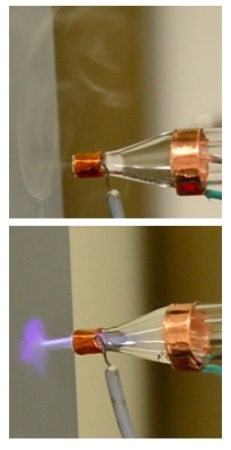Mar 24 2016
The printing process continuously evolved since the days of Johannes Gutenberg. A new technique has been developed by a team of researchers at NASA Ames and SLAC National Accelerator Laboratory, to print nanomaterials onto three-dimensional objects or flexible surfaces, such as a cloth or paper, using plasma. The breakthrough process has potential to help build devices, such as integrated circuits, flexible memory devices and batteries, wearable chemical and biological sensors, easily and cost-effectively.
 The nozzle firing a jet of carbon nanotubes with helium plasma off and on. When the plasma is off, the density of carbon nanotubes is small. The plasma focuses the nanotubes onto the substrate with high density and good adhesion. (credit: NASA Ames Research Center).
The nozzle firing a jet of carbon nanotubes with helium plasma off and on. When the plasma is off, the density of carbon nanotubes is small. The plasma focuses the nanotubes onto the substrate with high density and good adhesion. (credit: NASA Ames Research Center).
AIP Publishing’s Applied Physics Letters has featured a paper describing the breakthrough research.
Inkjet printers, similar to a standard printer used in offices, are commonly used for nanomaterials, such as nanotube and nanoparticle layers. They are cost effective and employ proven technology, but they have their own limitations. Printing on flexible materials, such as textiles and 3D objects, is not possible with inkjet printers. They use liquid ink to print and it is not easy to make all materials into a liquid.
Aerosol printing techniques can also be used to print certain nanomaterials, but heating up to several hundred degrees is required to consolidate the material into a thin and smooth film. Therefore, they are not suitable to print on cloths or other flammable materials. The process becomes expensive if it uses materials that withstand the heat.
The heating step is eliminated in the plasma method, which runs at temperatures no higher than 40°C.
You can use it to deposit things on paper, plastic, cotton, or any kind of textile. It's ideal for soft substrates.
Meyya Meyyappan, NASA Ames Research Center
Tthe printing material also doesn’t need to be a liquid.
The process has been demonstrated by printing a carbon nanotube layer on a paper. The nanotubes were mixed into a helium ion plasma and blasted onto the paper through a nozzle. The nanoparticles were focused onto the surface of the paper by the plasma, and as a result a consolidated layer was formed devoid of any additional heating.
Two simple biological and chemical sensors were printed by the team using the process. The carbon nanotubes would exhibit a variation in its electrical resistance when certain molecules are present. The concentration of these molecules can be identified and determined by the device through the measurement of the change in the electrical resistance. The team printed a biological sensor capable of detecting dopamine, a molecule associated with disorders such as epilepsy and Parkinson's disease, and a chemical sensor for detecting ammonia gas.
Meyyappan said these printed sensors were just simple proofs-of-principle.
There's a wide range of biosensing applications.
Meyya Meyyappan, NASA Ames Research Center
Sensors capable of monitoring food-borne pathogens, such as E. coli and Salmonella, and health biomarkers such as cholesterol can be printed using this method.
The use of a simple nozzle makes the method not only versatile but also easily scalable. Many nozzles that resemble a showerhead could be provided to print on large areas. The nozzles can also be used as a hose to freely spray nanomaterials onto 3D objects.
It can do things inkjet printing cannot do, but anything inkjet printing can do, it can be pretty competitive.
Meyya Meyyappan, NASA Ames Research Center
According to Meyyappan, the technique is ready to be commercialized as it is economical and simple to develop. The researchers are engineering the method to print other types of materials, such as copper. Battery materials can also be printed onto thin sheets of metals, such as aluminum. The resulting sheets are then rolled into tiny batteries to be used in devices such as cellphones.